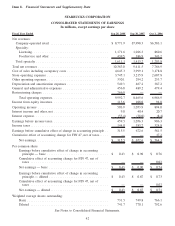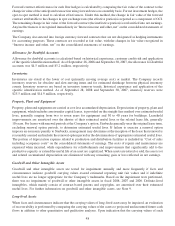Starbucks 2008 Annual Report Download - page 46
Download and view the complete annual report
Please find page 46 of the 2008 Starbucks annual report below. You can navigate through the pages in the report by either clicking on the pages listed below, or by using the keyword search tool below to find specific information within the annual report.the expected useful lives of long-lived assets and the ability of the Company to realize undiscounted cash flows in
excess of the carrying amounts of such assets are affected by factors such as the ongoing maintenance and
improvements of the assets, changes in economic conditions and changes in operating performance. As the
Company assesses the ongoing expected cash flows and carrying amounts of its long-lived assets, these factors
could cause the Company to realize material impairment charges.
Stock-based Compensation
Starbucks accounts for stock-based compensation in accordance with the fair value recognition provisions of
SFAS No. 123(R), “Share-Based Payment.” The Company uses the Black-Scholes-Merton option pricing model
which requires the input of subjective assumptions. These assumptions include estimating the length of time
employees will retain their stock options before exercising them (“expected term”), the estimated volatility of the
Company’s common stock price over the expected term and the number of options that will ultimately not complete
their vesting requirements (“forfeitures”). Changes in the subjective assumptions could materially affect the
estimate of fair value of stock-based compensation; however based on an analysis using changes in certain
assumptions that could be reasonably possible in the near term, management believes the effect on the expense
recognized for fiscal 2008 would not have been material.
Operating Leases
Starbucks leases retail stores, roasting and distribution facilities and office space under operating leases. The
Company provides for an estimate of asset retirement obligation (“ARO”) expense at the lease inception date for
operating leases with requirements to remove leasehold improvements at the end of the lease term. Estimating
AROs involves subjective assumptions regarding both the amount and timing of actual future retirement costs.
Future actual costs could differ significantly from amounts initially estimated. In addition, the large number of
operating leases and the significant number of international markets in which the Company has operating leases
adds administrative complexity to the calculation of ARO expense, as well as to the other technical accounting
requirements of operating leases such as contingent rent. Starbucks accounts for lease contract termination costs in
accordance with SFAS 146, “Accounting for Costs Associated with Exit or Disposal Activities.” Estimating the cost
of certain lease exit costs involves subjective assumptions, including the time it would take to sublease the leased
location and the related potential sublease income. The estimated accruals for these costs could be significantly
affected if future experience differs from that used in the initial estimate.
Self Insurance Reserves
The Company uses a combination of insurance and self-insurance mechanisms, including a wholly owned captive
insurance entity and participation in a reinsurance pool, to provide for the potential liabilities for workers’
compensation, healthcare benefits, general liability, property insurance, director and officers’ liability insurance
and vehicle liability. Liabilities associated with the risks that are retained by the Company are not discounted and
are estimated, in part, by considering historical claims experience, demographic factors, severity factors and other
actuarial assumptions. The estimated accruals for these liabilities could be significantly affected if future occur-
rences and claims differ from these assumptions and historical trends.
Income Taxes
Starbucks accounts for income taxes in accordance with SFAS No. 109, “Accounting for Income Taxes,” which
recognizes deferred tax assets and liabilities based on the differences between the financial statement carrying
amounts and the tax basis of assets and liabilities. Accruals for uncertain tax positions are accounted for under
FASB Interpretation No. 48, “Accounting for Uncertainty in Income Taxes, an interpretation of FASB Statement
No. 109” (“FIN 48”). Deferred tax assets and liabilities are measured using current enacted tax rates in effect for the
years in which those temporary differences are expected to reverse. Judgment is required in determining the
provision for income taxes and related accruals, deferred tax assets and liabilities. These include establishing a
valuation allowance related to the realizability of certain deferred tax assets. Accounting for uncertain tax positions
requires significant judgments, including estimating the amount, timing and likelihood of ultimate settlement.
Although the Company believes that its estimates are reasonable, actual results could differ from these estimates.
40
























